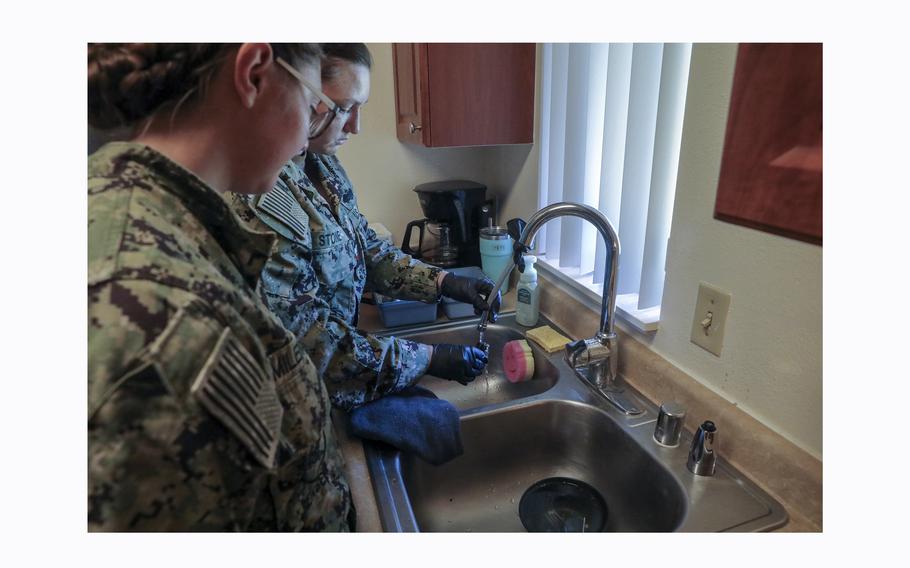
Members of the Navy’s Rapid Response Team test tap water at an Aliamanu Military Reservation home in Honolulu on March 21, 2024. (Glenn Slaughter/U.S. Navy)
HONOLULU — A pair of environmental scientists testified in Hawaii federal court Tuesday that more than 2,000 gallons of jet fuel from a spill at a Navy fuel facility in late 2021 made its way into drinking water used by more than 90,000 residents living near Pearl Harbor.
Only that level of jet fuel contamination could account for the oily sheen many residents saw in the foul-smelling water coming from their taps, they testified.
The experts testified for the plaintiffs on the second day of trial for Feindt vs. United States, the civil suit brought by the first 17 individuals claiming medical, emotional and financial injury from the contaminated water. Their claims originated with the Nov. 21, 2021, spill at the Red Hill Bulk Fuel Storage Facility a few miles from Joint Base Pearl Harbor-Hickam.
More than 7,500 additional plaintiffs have joined several other lawsuits also seeking compensation.
U.S. District Court Judge Leslie Kobayashi is hearing the case without a jury.
Some jet fuel from that spill seeped into the Navy’s Red Hill well, about 3,000 feet from the facility. The Navy isolated that well from its system on Nov. 28, 2021, and flushed the entire system during the first months of 2022.
Just how much jet fuel made its way into the distribution system and into residents’ homes is a matter of dispute between the parties.
During opening arguments Monday, attorneys representing the federal government asserted that the contamination was too minute and too short-lived to have caused long-lasting medical problems claimed by the plaintiffs, which include rashes, abdominal pains, hair loss, dizziness, vomiting, brain fog and a host of other conditions.
Joseph Hughes, a professor at Drexel University’s College of Engineering, testified Tuesday that 2,024 gallons of jet fuel were pumped out of the Red Hill well and into the Navy’s water system.
Paul Rosenfeld, who holds a doctorate in soil chemistry and is a co-founder of the environmental consulting firm Soil Water Air Protection Enterprise, testified that between 2,000 to 2,500 gallons of jet fuel ultimately got into the water distribution system via the Red Hill well.
Hughes said he based his estimate partially on the behavior of “light non-aqueous phase liquids,” or LNAPLs, when combined with water.
LNAPLs are hydrocarbon liquids, such as gasoline, diesel and other petroleum products that are lighter than water and do not readily mix.
Jet fuel floats on water, but it will dissolve when mixed if the level of jet fuel is less than 5 milligrams per liter, Hughes said.
“Greater than that creates a sheen,” he said.
Thus, the visible sheen that some residents saw in cups, bowls and sinks in homes on the Navy water system in late November 2021 was evidence that jet fuel had entered the Navy’s water system at levels that exceeded solubility, Hughes said.
Hughes said he based his estimate on “bailer” tests taken in the Red Hill well after it had been shut down.
That test, done by lowering a cylinder into the groundwater that then traps a cross section inside, provides a relatively accurate reading of LNAPLs resting on the water’s surface, he said.
Under cross examination by Justice Department attorney Eric Rey, Hughes acknowledged that water samples tested by other means during that period detected no presence of petroleum.
But according to Rosenfeld’s declaration filed with the court, the Navy was using a test during the crucial days after the contamination that was “highly inaccurate” in detecting “total petroleum hydrocarbons” in the water.
Total petroleum hydrocarbons describes a group of hundreds of chemical compounds that originated from crude oil.